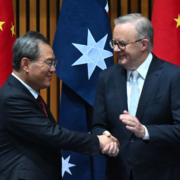Chinese navy transit: opinions in The Strategist

Views in The Strategist on the recent Chinese warship deployment near Australia range from ‘get used to it’, to a warning against overreaction and a welcoming of the resulting debate over defence. Here are introductions and links to the articles:
China will continue to conduct unsafe military manoeuvres and we can expect to see more advanced warships in our region, writes Joe Keary.
While the frequency and duration of deployments have been limited by a lack of support ships and overseas support bases, Chinese military developments show its goal of a navy capable of projecting power into our region and beyond.
As China’s navy improves its logistics and defensive capabilities, a lack of overseas bases will only slow, not stop, China’s ambition to project naval forces into global environs (including Australia’s) more often and for longer durations.
China’s demonstration of its advanced naval capabilities highlights Australia’s shortcomings, writes Jennifer Parker.
While China’s fleet has grown in number and capability, Australia’s fleet has aged and shrunk. This leaves Australia unprepared to protect its maritime security interests.
China’s naval demonstration on Australia’s east coast should serve a reminder of our vulnerability, and a warning that addressing this vulnerability requires Australia to truly recognise its place as a maritime power.
The deployment to nearby international waters raises the question of what Australia could do if China sortied into its waters, writes Ian Langford.
In the short-term, it should step up equipping the Australian Army for maritime defence.
Despite the fleet of ships remaining in international waters and the comments from many that this activity raises no concerns for our future defence capability plans, it nonetheless does reflect on our current military capacity and highlights the urgent need for ongoing improvements in force projection, sea control and, where necessary, maritime strike.
An Australian overreaction to China’s deployment jeopardises our own necessary activities in the South China Sea and North-East Asia, writes Jennifer Parker in another article.
Australia’s best response would be to expand our own maritime capabilities to effectively exercise our own rights and protect our interests.
The freedom of the seas is fundamental to our security as a maritime trading nation. Claims that China’s warships shouldn’t be operating in our exclusive economic zone or conducting live-fire exercises on the high seas undermines this principle, giving China a propaganda win to challenge our necessary deployments to North-East Asia and the South China Sea—routes that carry two-thirds of our maritime trade.
But the Chinese navy’s activation of political debate over defence policy is welcome, writes Euan Graham.
Noting legal reciprocity of freedom of navigation, countries have a duty to act professionally. The lack of advance warning and the flotilla’s transit were a message to which the Australian government should respond.
…ordinary Australians are quite entitled to read hostility in China’s intentions. The flotilla was not invited here, and China didn’t notify us it was coming. Carrying out live fire exercises in the Tasman Sea with little or no notice, as the flotilla did on 21 February, wasn’t just unprofessional; it sent an unmistakably coercive signal to Australia and New Zealand.
China has long used naval transits to send a message, but the pace has increased in recent years, writes Joe Keary.
They are known to monitor exercises, float around defence facilities and appear around election time. The expansion of activities reflects China’s ambition to grow the strength and capability of its navy and to project power into our region.
Together, these deployments paint a picture of a country that is undertaking sweeping efforts to transform its navy into a formidable blue water force, capable of regularly projecting hard and soft power to our region.

 China's Premier Li Qiang (L) and Australia's Prime Minister Anthony Albanese shake hands during a signing ceremony at Parliament House in Canberra on June 17, 2024. (Photo by LUKAS COCH / POOL / AFP) (Photo by LUKAS COCH/POOL/AFP via Getty Images)
China's Premier Li Qiang (L) and Australia's Prime Minister Anthony Albanese shake hands during a signing ceremony at Parliament House in Canberra on June 17, 2024. (Photo by LUKAS COCH / POOL / AFP) (Photo by LUKAS COCH/POOL/AFP via Getty Images)